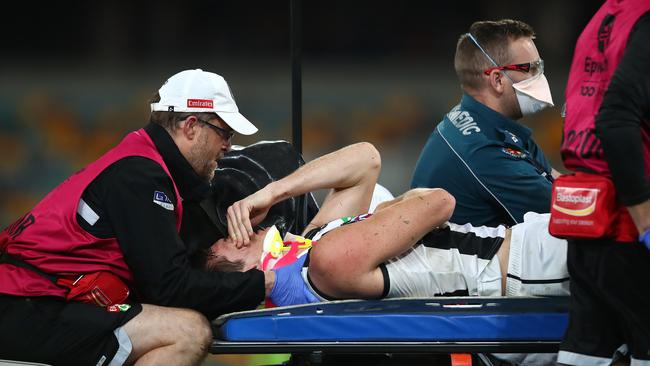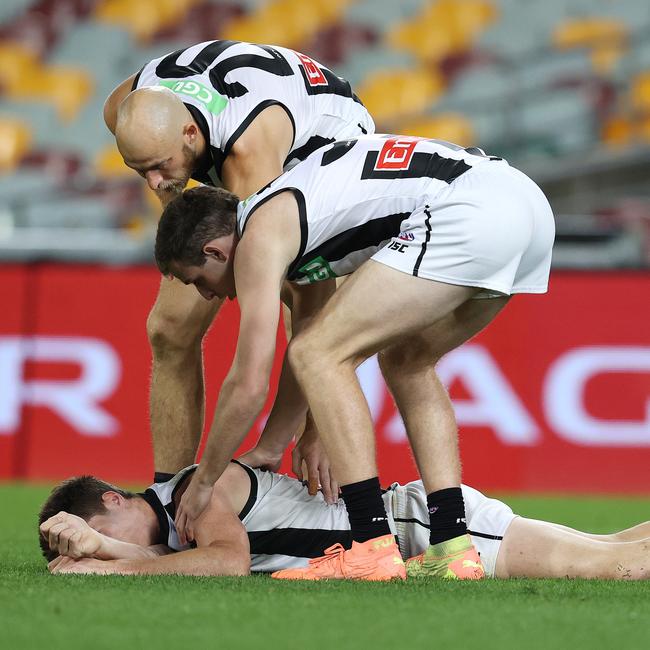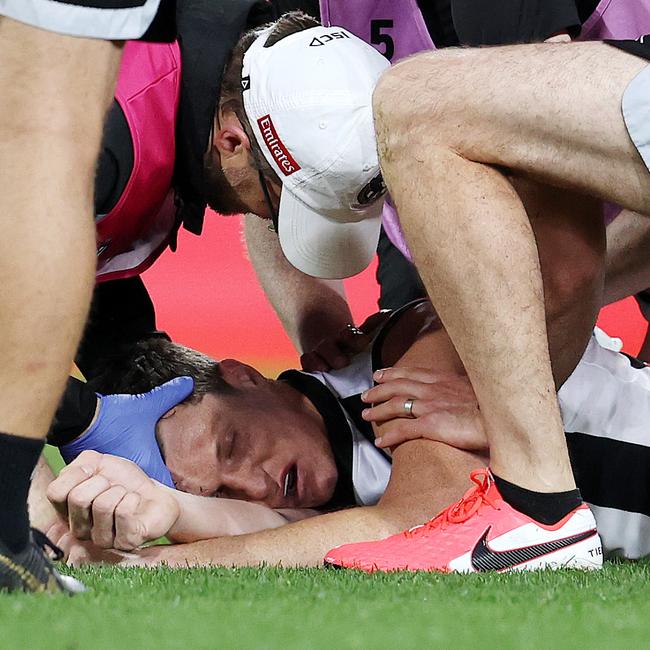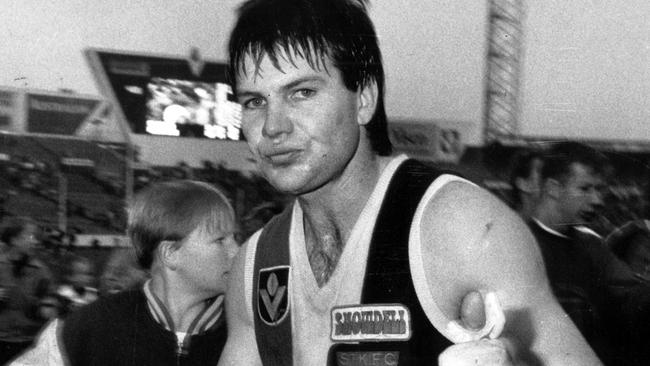AFL’s new concussion protocols not tough enough say medical experts
Players fear long-term brain damage, lawyers say the walls are closing in on the AFL administration. Is science the last hope? Mick Warner reports

AFL
Don't miss out on the headlines from AFL. Followed categories will be added to My News.
Brody Mihocek lies motionless at the top of the Gabba goalsquare. He’s been knocked out cold in a sickening collision with Melbourne’s Aaron vandenBerg.
“That would just magnify the distance away for the family right now,” commentator Bob Murphy laments as last year’s Round 12 match is paused to allow medical staff to place the Collingwood forward onto a stretcher and into a waiting ambulance.
“It would be really difficult for Mihocek’s family to watch that.”
But as the days ticked down to the Magpies’ next game, nine days later against North Melbourne, club football boss Geoff Walsh revealed Mihocek had recovered well and was likely to play.
“What looked like it could have been a nasty injury has shaped up to be not too bad and in all likelihood seeing our game is still seven days away … Brody will be fit for selection and cleared, so that is good news,” Walsh said.
Not surprisingly, it divided opinion.
“He was carried off on a stretcher and there is talk of him playing again this week — that’s just absolutely nuts,” former Demons star and high-profile concussion victim Shaun Smith declared.

“They shouldn’t even be talking about it.
“That young kid Kyron Hayden at North Melbourne got absolutely poleaxed (in Round 7) and he played the next week and I just think it shows that the AFL haven’t learnt a thing.
“You can’t tell me if you get knocked out, which is a fairly major brain trauma, that you’re going to recover within a week.”
Mihocek would end up missing the match, but it seems the AFL has indeed “learnt” a few things in recent months about head knocks.
Under the league’s new return-to-play protocols for 2021, both Mihocek and Hayden would be forced to sit out the next match, regardless of how they presented.
The AFL confirmed on Thursday it would sideline all players who suffer a concussion for at least 12 days this year – up from six days.
It’s a clear admission from AFL HQ that more needs to be done to tackle the scourge of concussion.
Footy’s concussion landscape has shifted alarmingly since the Mihocek hit.
Just weeks after speaking out, Smith made headlines again when it was revealed he had pocketed a massive $1.4 million insurance payout because of crippling brain injuries suffered while playing football.
MLC paid up after recognising that 51-year-old Smith had suffered a “total and permanent disablement” as a result of repeated head knocks.

The landmark payment (sure to have made insurance firms across the country rethink their exposure) came just days after it was revealed St Kilda legend Danny Frawley had been diagnosed post-death with the devastating brain disease chronic traumatic encephalopathy (CTE).
Footy great Graham “Polly” Farmer, who died in August 2019, became the first Australian Rules player diagnosed with CTE, followed by Frawley and then earlier this year the late Richmond player Shane Tuck.
Greg Griffin, the South Australian lawyer behind a proposed concussion damages class action against the league involving more than 100 former players suffering from mental health issues, says the AFL is about to face a reckoning after decades of denial and obfuscation.
“The walls aren’t just closing in, they’re collapsing,” Griffin said.
“This latest change simply does not go anywhere near far enough, but what they are trying to do, in my opinion, is to give the impression to the football public that the position they have taken over the last 20 years has been justified.
“This is a mere tweaking of that position as opposed to an acknowledgment that its concussion protocols have been medically unsustainable – and directly causative of some horrendous injuries to its players.”
Griffin likens the AFL’s stance on concussion to that of the asbestos industry and Big Tobacco.
“They have repeatedly decried any medical opinion which dared to suggest that players needed to rest after concussion and that the game was dangerous and there needed to be very strict laws to protect players,” he said.
“Sadly, there will be so many more Danny Frawley’s to come. But every time a retired player has an autopsy, which reveals he had CTE, the AFL just can’t build another ‘Danny Frawley concussion centre’.
“In my view, the concussion horse bolted 20 years ago.”
Griffin says the game’s concussion crisis also looms as a “huge problem” for the Victorian Government. WorkSafe Victoria is conducting its own independent inquiry into the AFL’s concussion protocols.

“The Government has to realise that they now have a huge problem with the way the league has handled its return-to-play concussion protocols, which have caused people to die. It’s as simple as that,” he said.
Griffin has called on the Government to remove any person on the WorkSafe board with an affiliation with the AFL.
Former league corporate affairs boss Elizabeth Lukin is among nine WorkSafe directors.
Asked about the conflict of interest claims this week, a WorkSafe spokesman said: “WorkSafe board members follow state government guidelines for declaring and managing conflicts of interest, including removing themselves from discussions if, or when a conflict may arise.”
The AFL’s amended protocols come as a report conducted by leading concussion researcher Dr Alan Pearce found that changes enforced on the eve of last year’s season had failed to increase the amount of time concussed players spent on the sidelines.
The report, based on publicly available AFL injury data, concluded that players suffering from head knocks took an average of 11 days to return to matches last year, compared to 19 days in 2019, 17 in 2018 and 13 in 2017.
“It is well described that medical staff can be pressured to clear players to return to competition as quickly as possible, and this pressure comes from multiple sources including
the athlete themselves,” the report asserted.
“In the extraordinary year of 2020, these pressures may have been amplified, thus leading to a shorter than average return-to-play time. But this does not excuse the possibility that many players with a concussion in 2020 have been prematurely returned to the game, risking further injury and the potential post-concussion effects …
“Sporting codes should be erring on the side of caution and mandating that at least one match be missed after suffering a concussion.”

Prof Pearce, from La Trobe University and the Victorian-based affiliate of the Australian Sports Brain Bank in Sydney where the brains of Farmer, Frawley and Tuck were analysed, believes players suffering heavy concussions should be sidelined for a minimum of 30 days to allow the human brain to “recover properly, so it reduces inflammation and the brain’s immune cells can repair the micro-damage”.
It’s a draconian call that prompts many to ponder whether the game can survive long-term in its current form.
But Prof Pearce says it is in the field of science where contact sports such as Australian Rules will find the solution (not the cure) to the concussion dilemma.
“When you get a hit to the brain you get a whole release of different molecules, proteins and even some neurotransmitters, which allow brain cells to talk to each other,” he said.
While the technology is in its infancy, he envisaged a situation a decade on where an AFL player took a knock, came to the bench and was given a saliva swab or pin prick blood test.
“My hope is that within 15 minutes – almost like a COVID test – the doctor would have the results and say, ‘OK, we’ve taken a reading, and it’s too high – you can’t go back on’.
“At the moment we see players coming back on and automatically blame the doctor or the coach, but this would take all of the doubt away.”
In the Mihocek case, Pearce said he hoped science would soon allow medicos to use blood tests or urine tests to precisely track the brain’s recovery.
“As the brain recovers, those molecules will come back to baseline and that tells us that the brain is now recovered,” he said.
“I’d be optimistic at five years but more confident at 10.”
He said he was surprised the AFL and other major sporting codes weren’t investing in the technology.
“It’s our only chance really because what is happening at the moment needs something to increase the rigour – and science is normally the way to go about that,” he said.

Long-time concussion campaigner Peter Jess said he first warned the AFL about CTE and the dangers of subclinical concussions (where players take a knock but are not KO’d) in 2009.
“They effectively said CTE was an American problem and did not figure as a consequence in Australian football,” Jess said.
The veteran player agent has managed over 1000 VFL/AFL players since the early 1980s and says “the majority” have endured a degree of mental health problems.
“The extent of the damage is acute through to mild,” Jess said.
“Anybody that has played for more than five years is going to have an issue and that issue will manifest itself over time.
“Throughout this period, the AFL has spent — of its own money — zero dollars on concussion research and yet at the same time they saw fit to reward their executives with multimillion-dollar bonuses while continuing to ignore all of the compelling science and medical evidence and the catastrophic trauma that was happening to the playing cohort.”
It was revealed in 2019 that $250,000 in AFL player fines had been used to fund the league’s contribution to concussion research.
“While the AFL has taken a brave step in introducing a 12-day rest period it has not addressed the most dangerous part of the game, which is the accumulation of subclinical concussions that create the industrial disease, CTE,” he said.
Jess, who said he had written repeatedly to the AFL commission outlining his concerns about the current return-to-play protocols, said the day was coming when the AFL and its commissioners would be held to account.
“The most disturbing thing is that there is still a continuing denial from within the AFL and their medical fraternity that damage is happening – and it is in front of them regularly,” he said.



